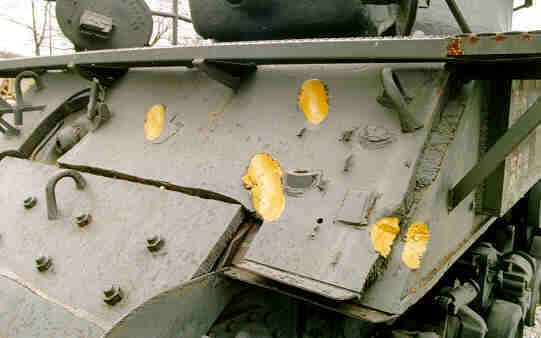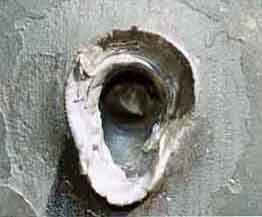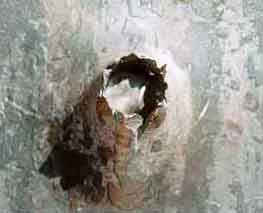
Anti-tank round hits on Sherman frontal armor


Entrance and exit ballistics of a Russian PTRS41 14.5 mm anti-tank rife round in an A36 steel plate (1 inch thick) at slight obliquity

Anti-tank round hits on Sherman frontal armor


Entrance and exit ballistics of a Russian PTRS41 14.5 mm anti-tank rife round in an A36 steel plate (1 inch thick) at slight obliquity
The following table shows armor penetration capability for various munitions used in WWII. This table is being researched from a wide variety of references on the subject. The purpose of the table is to develop a technical basis for the determination of outcomes from gun versus armor engagements in tactical reenactment battles hosted by various WWII reenactment groups. If you have additional information not shown in the tables below, our research department would be very interested in obtaining the data (along with references) to add to this data base. Please e-mail us with your contribution.
| WEAPON TYPE | MUNITION TYPE | Range 100m | Range 500m | Range 1000m | Range 1500m | Range 2000m | Reference |
|---|---|---|---|---|---|---|---|
| 20mm GUN AN-M2 | AP-M95 | 22mm | 18mm | 13mm | 8mm | 7mm | 4 |
| 37MM M6 GUN | M51AP | 63mm | 54mm | 45mm | 37mm | - | 2 |
| 37mm GUN M6 Squeeze Bore | Tungsten Carbide | 118mm | 85mm | 59mm | 46mm | - | 3 |
| 75MM GUN | AP-T | 87mm | 73mm | 65mm | 54mm | 45mm | 1 |
| 75MM GUN | APCR-T | 135mm | 115mm | 95mm | 76mm | 60mm | 1 |
2. "Stuart, U.S. Light Tanks in Action", Squadron/Signal Publications, Number 18, 1979.
3. "Fire and Movement", The Tank Museum at Bovington, Dorset, England 1975.
4. "Ballistic Data Performance of Ammunition", TM9-1907, Department of the Army, July 1948.
 BACK TO ROBERTS ARMORY HOME PAGE
BACK TO ROBERTS ARMORY HOME PAGE